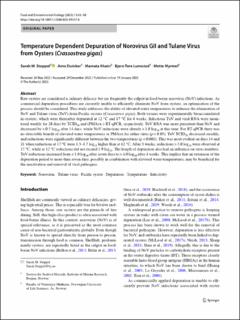| dc.contributor.author | Stoppel, Sarah Marie | |
| dc.contributor.author | Duinker, Arne | |
| dc.contributor.author | Khatri, Mamata | |
| dc.contributor.author | Lunestad, Bjørn Tore | |
| dc.contributor.author | Myrmel, Mette | |
| dc.date.accessioned | 2023-10-10T10:23:29Z | |
| dc.date.available | 2023-10-10T10:23:29Z | |
| dc.date.created | 2023-03-07T08:45:24Z | |
| dc.date.issued | 2023 | |
| dc.identifier.citation | Food and Environmnetal Virology. 2023, 1-8. | |
| dc.identifier.issn | 1867-0334 | |
| dc.identifier.uri | https://hdl.handle.net/11250/3095436 | |
| dc.description.abstract | Raw oysters are considered a culinary delicacy but are frequently the culprit in food-borne norovirus (NoV) infections. As commercial depuration procedures are currently unable to efficiently eliminate NoV from oysters, an optimisation of the process should be considered. This study addresses the ability of elevated water temperatures to enhance the elimination of NoV and Tulane virus (TuV) from Pacific oysters (Crassostrea gigas). Both viruses were experimentally bioaccumulated in oysters, which were thereafter depurated at 12 °C and 17 °C for 4 weeks. Infectious TuV and viral RNA were monitored weekly for 28 days by TCID50 and (PMAxx-) RT-qPCR, respectively. TuV RNA was more persistent than NoV and decreased by < 0.5 log10 after 14 days, while NoV reductions were already > 1.0 log10 at this time. For RT-qPCR there was no detectable benefit of elevated water temperatures or PMAxx for either virus (p > 0.05). TuV TCID50 decreased steadily, and reductions were significantly different between the two temperatures (p < 0.001). This was most evident on days 14 and 21 when reductions at 17 °C were 1.3–1.7 log10 higher than at 12 °C. After 3 weeks, reductions > 3.0 log10 were observed at 17 °C, while at 12 °C reductions did not exceed 1.9 log10. The length of depuration also had an influence on virus numbers. TuV reductions increased from < 1.0 log10 after seven days to > 4.0 log10 after 4 weeks. This implies that an extension of the depuration period to more than seven days, possibly in combination with elevated water temperatures, may be beneficial for the inactivation and removal of viral pathogens. | |
| dc.language.iso | eng | |
| dc.title | Temperature Dependent Depuration of Norovirus GII and Tulane Virus from Oysters (Crassostrea gigas) | |
| dc.title.alternative | Temperature Dependent Depuration of Norovirus GII and Tulane Virus from Oysters (Crassostrea gigas) | |
| dc.type | Peer reviewed | |
| dc.type | Journal article | |
| dc.description.version | publishedVersion | |
| dc.source.pagenumber | 1-8 | |
| dc.source.journal | Food and Environmnetal Virology | |
| dc.identifier.doi | 10.1007/s12560-022-09547-8 | |
| dc.identifier.cristin | 2131779 | |
| cristin.ispublished | true | |
| cristin.fulltext | original | |
| cristin.qualitycode | 1 | |
